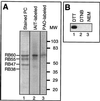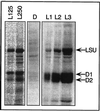Translation of chloroplast psbA mRNA is modulated in the light by counteracting oxidizing and reducing activities
- PMID: 10648596
- PMCID: PMC85229
- DOI: 10.1128/MCB.20.4.1116-1123.2000
Translation of chloroplast psbA mRNA is modulated in the light by counteracting oxidizing and reducing activities
Abstract
Light has been proposed to stimulate the translation of Chlamydomonas reinhardtii chloroplast psbA mRNA by activating a protein complex associated with the 5' untranslated region of this mRNA. The protein complex contains a redox-active regulatory site responsive to thioredoxin. We identified RB60, a protein disulfide isomerase-like member of the protein complex, as carrying the redox-active regulatory site composed of vicinal dithiol. We assayed in parallel the redox state of RB60 and translation of psbA mRNA in intact chloroplasts. Light activated the specific oxidation of RB60, on the one hand, and reduced RB60, probably via the ferredoxin-thioredoxin system, on the other. Higher light intensities increased the pool of reduced RB60 and the rate of psbA mRNA translation, suggesting that a counterbalanced action of reducing and oxidizing activities modulates the translation of psbA mRNA in parallel with fluctuating light intensities. In the dark, chemical reduction of the vicinal dithiol site did not activate translation. These results suggest a mechanism by which light primes redox-regulated translation by an unknown mechanism and then the rate of translation is determined by the reduction-oxidation of a sensor protein located in a complex bound to the 5' untranslated region of the chloroplast mRNA.
Figures








Similar articles
-
Translation of the psbA mRNA of Chlamydomonas reinhardtii requires a structured RNA element contained within the 5' untranslated region.J Cell Biol. 1994 Dec;127(6 Pt 1):1537-45. doi: 10.1083/jcb.127.6.1537. J Cell Biol. 1994. PMID: 7798310 Free PMC article.
-
Translation of chloroplast psbA mRNA is regulated by signals initiated by both photosystems II and I.Proc Natl Acad Sci U S A. 2001 Oct 9;98(21):12289-94. doi: 10.1073/pnas.211440698. Epub 2001 Oct 2. Proc Natl Acad Sci U S A. 2001. PMID: 11593046 Free PMC article.
-
Translation of the chloroplast psbA mRNA requires the nuclear-encoded poly(A)-binding protein, RB47.J Cell Biol. 1998 Jul 27;142(2):435-42. doi: 10.1083/jcb.142.2.435. J Cell Biol. 1998. PMID: 9679142 Free PMC article.
-
Chloroplast site-directed mutagenesis of photosystem I in Chlamydomonas: electron transfer reactions and light sensitivity.Biochimie. 2000 Jun-Jul;82(6-7):635-45. doi: 10.1016/s0300-9084(00)00604-0. Biochimie. 2000. PMID: 10946112 Review.
-
Synthesis, membrane insertion and assembly of the chloroplast-encoded D1 protein into photosystem II.FEBS Lett. 2002 Feb 13;512(1-3):13-8. doi: 10.1016/s0014-5793(02)02218-4. FEBS Lett. 2002. PMID: 11852043 Review.
Cited by
-
Selenocystamine improves protein accumulation in chloroplasts of eukaryotic green algae.AMB Express. 2015 Dec;5(1):126. doi: 10.1186/s13568-015-0126-3. Epub 2015 Jul 3. AMB Express. 2015. PMID: 26137911 Free PMC article.
-
New In Vivo Approach to Broaden the Thioredoxin Family Interactome in Chloroplasts.Antioxidants (Basel). 2022 Oct 4;11(10):1979. doi: 10.3390/antiox11101979. Antioxidants (Basel). 2022. PMID: 36290702 Free PMC article.
-
Thioredoxins in chloroplasts.Curr Genet. 2007 Jun;51(6):343-65. doi: 10.1007/s00294-007-0128-z. Epub 2007 Apr 13. Curr Genet. 2007. PMID: 17431629 Review.
-
Identification of proteins targeted by the thioredoxin superfamily in Plasmodium falciparum.PLoS Pathog. 2009 Apr;5(4):e1000383. doi: 10.1371/journal.ppat.1000383. Epub 2009 Apr 10. PLoS Pathog. 2009. PMID: 19360125 Free PMC article.
-
Rapid induction of a protein disulfide isomerase and defense-related genes in wheat in response to the hemibiotrophic fungal pathogen Mycosphaerella graminicola.Plant Mol Biol. 2003 Nov;53(5):701-14. doi: 10.1023/B:PLAN.0000019120.74610.52. Plant Mol Biol. 2003. PMID: 15010608
References
-
- Barber J, Anderson B. Too much of a good thing: light can be bad for photosynthesis. Trends Biochem Sci. 1992;17:61–66. - PubMed
Publication types
MeSH terms
Substances
LinkOut - more resources
Full Text Sources
